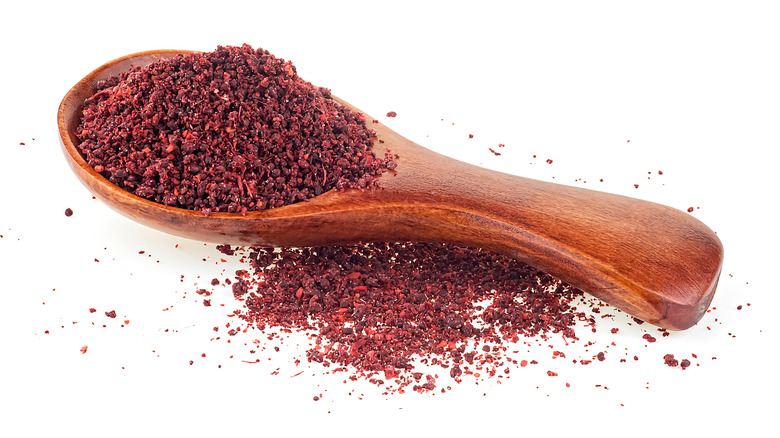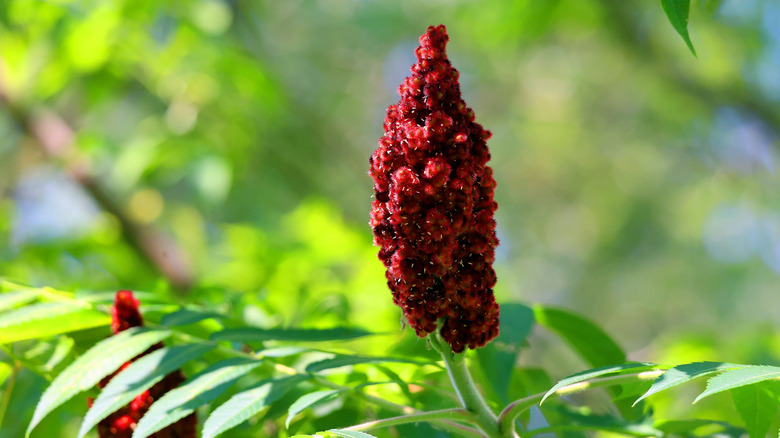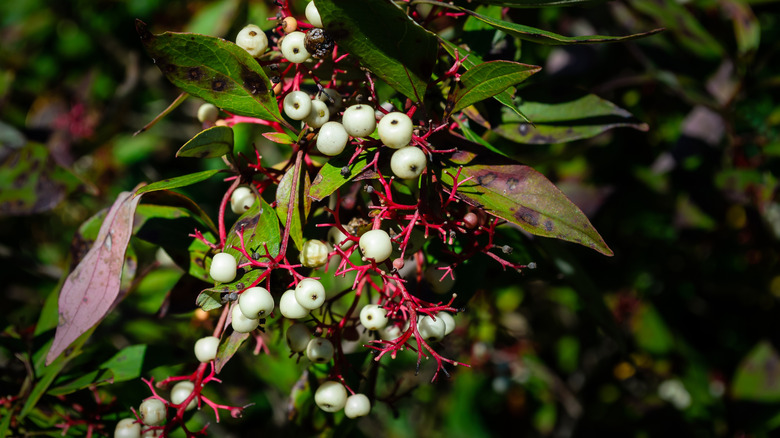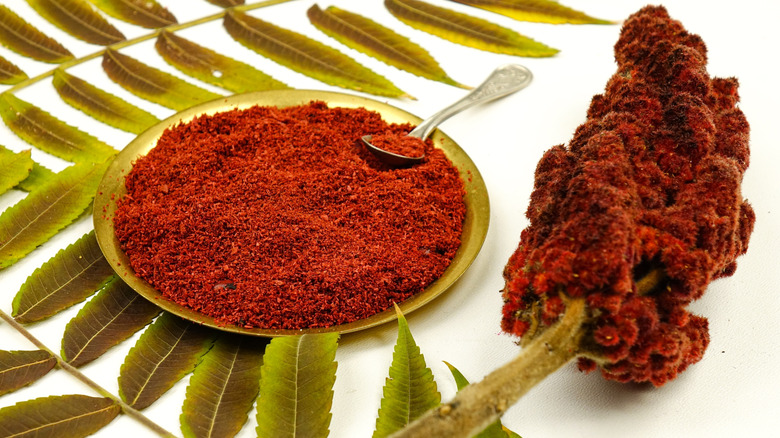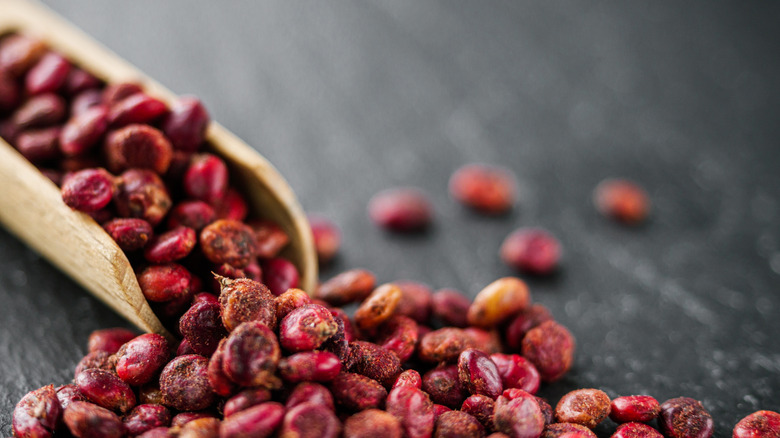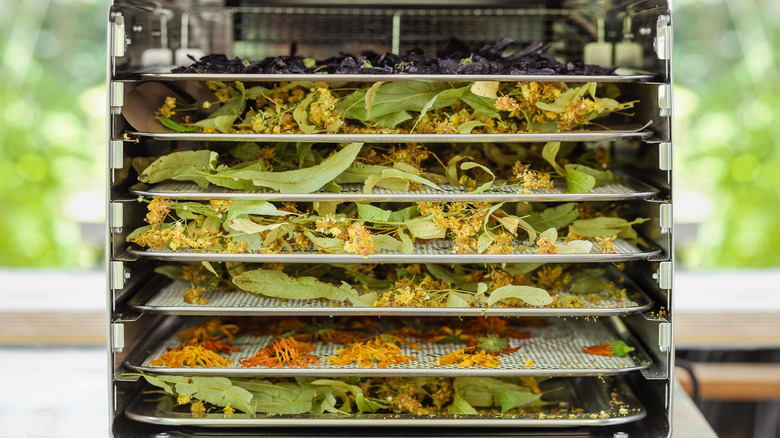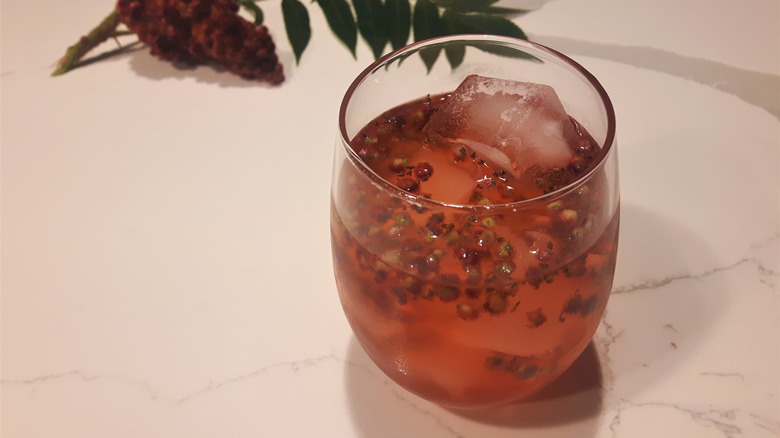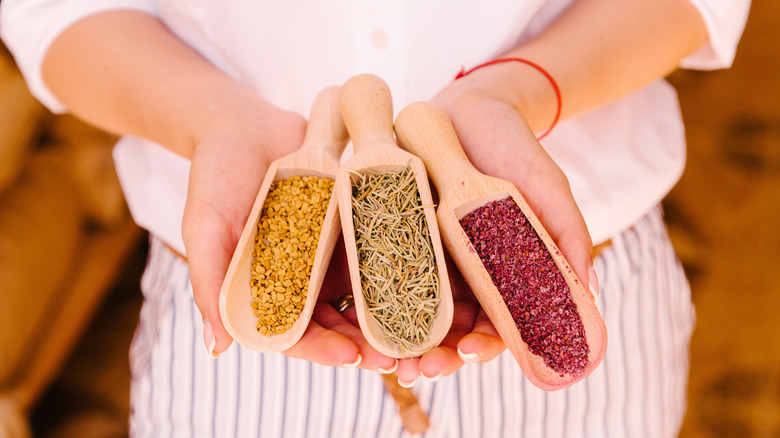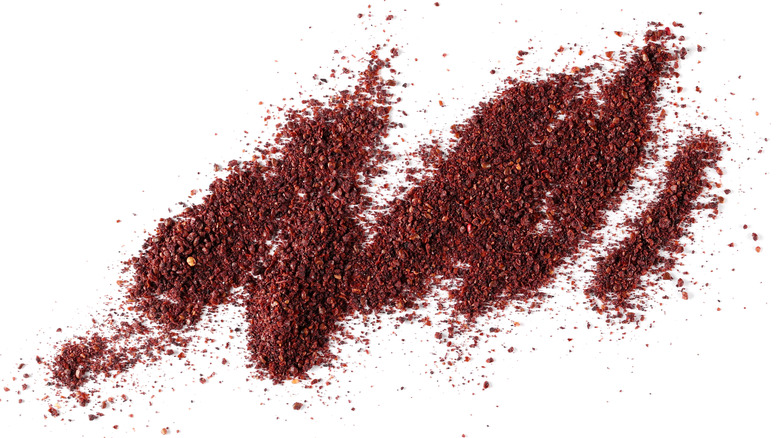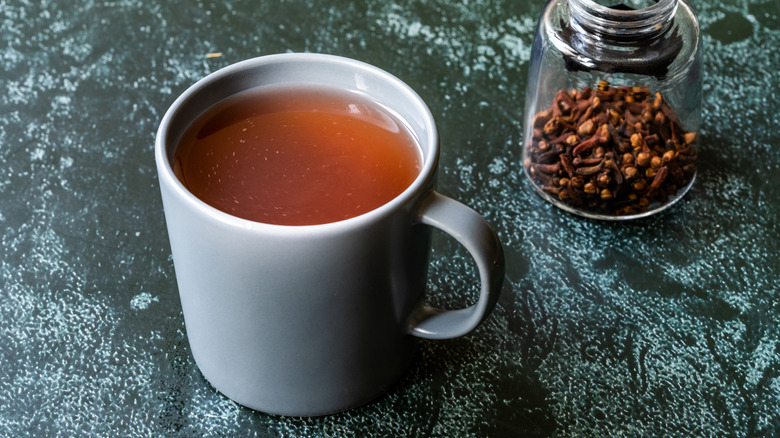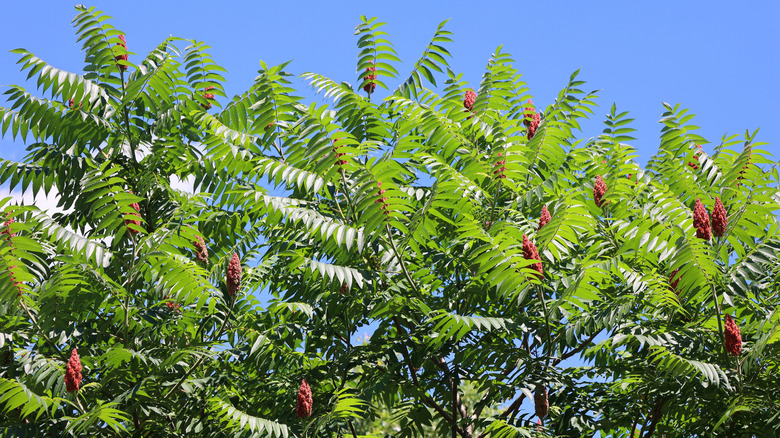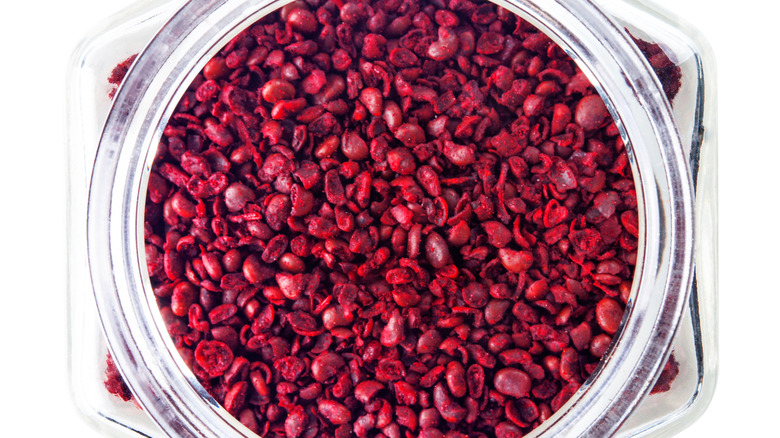What Is Sumac And How Should You Use It?
We may receive a commission on purchases made from links.
Sumac is a spice that has been gaining wider visibility over the past couple of decades. It's long been very popular in Mediterranean and Middle Eastern cooking, and indigenous populations in North America have used the berries for centuries as well. Luckily for home cooks, it's also one of the easier spices to use, as well as one of the more versatile, pairing well with everything from meat to fruit salads.
Yet despite its popularity, sumac still suffers from a couple of issues with its image in the U.S. One is that a lot of people think of poison sumac when they hear the name, even though the spice sumac is safe to use. Another is that if you're just not into Middle Eastern or Mediterranean food, and you didn't grow up in an area where "sumac-ade" was a summer drink, you're not likely to come across recipes that use sumac. So, if you're just now hearing about this subtly tart spice, here's information on what sumac is and how you can use it.
What is sumac?
Sumac is a spice that comes from the berries of a sumac tree or shrub. Two of the better-known varieties of sumac are staghorn sumac (Rhus typhina or Rhus hirta), which is common in North America, and Rhus coriaria, which is one of the more common Mediterranean species. Sumac can be used in berry form, but for most people in the U.S., it's better known as a powdered red spice.
No one is really sure where sumac plants truly first originated, and you'll find regions like Sicily and Iran vying for that particular title. And that's just for Mediterranean and Middle Eastern sumac; there are several varieties that grow around the world. One thing that is known for sure is that the berries and dried spice have all been used for centuries for food, drinks, medicine, and even industrial uses like dyeing material. In North America, sumac species can grow in regions as diverse as the Pacific Northwest and the South.
Culinary sumac is not poison sumac
One of the first questions people often have when they first hear of sumac is whether or not this is the same as poison sumac. Poison sumac is related to poison ivy and poison oak; these are all members of the Toxicodendron genus, and all three contain urushiol, the substance that gives you that terrible rash when you come into contact with the plants. The confusion is understandable. If you go far enough back in the taxonomic tree, both poison sumac and edible sumac are members of the same plant family. However, there are ways to tell which plant is which.
Edible sumac has red berries that grow in very tight clusters at the end of a branch. Poison sumac has white berries that tend to droop and that aren't clustered as tightly. Edible sumac spice is red; you won't see white sumac bottled and sold as a spice. Edible sumac trees also tend to prefer drier soils. They can grow in humid areas, but they typically don't grow in swampy land. Poison sumac plants tend to do the opposite; they can grow outside swamps but do like those swampy areas better. That said, if you're still not sure what you're dealing with, don't touch it.
How is the spice harvested or produced?
Sumac berries are harvested off trees or shrubs. When the clusters of berries are ripe, each cluster is cut off. One of the difficulties of dealing with fresh sumac berries is that the flavoring comes from acids that sit on the outside of the fruits, and too much water can wash those away. However, staghorn sumac berries from plants in North America also have little hairs that are undesirable to eat, and many varieties are also bug food. So, when you harvest a cluster of berries, you need to wash them to clean away the hairs, bugs, and any dirt, but you don't want to wash them for too long because then the acids will wash away.
You'll find various methods online for separating the berries from the stems and for removing the hairs. Some let the berries sit in a bag to dry first, while others remove the berries and then let them dry. Some also place the berries in a strainer and shake to separate the hairs and berries.
Fresh vs. dried sumac
Unless you're able to access a sumac tree (or have a nice neighbor or friend who has access), you'll have to use the dried version of sumac. Just about all recipes call for the dried version anyway, especially the powder. The powder is also the easiest to use, as there's no crushing, soaking, or cleaning involved; you measure what you need, and that's that.
Fresh berries that have been cleaned — never use them straight off a tree without cleaning them as they often harbor insects and a lot of dirt — are great for drinks like tea and sumac-infused lemonade. Crushing them and steeping them in cold water for up to 15 minutes gives you a tart liquid that you can sweeten with sugar; you can also steep the berries in cold water for several hours and then strain the liquid to get a tart iced tea.
Can you make your own dried sumac at home?
If you have access to sumac trees, such as a staghorn sumac in North America, you can harvest the berries yourself and dry them. You'll want to be absolutely sure that you recognize the tree; sumac has a couple of lookalikes in the U.S. that don't produce edible fruit. You'll also need to ensure you have permission from the landowner if the tree in your sights isn't on your own property. Also, don't forage from trees near streets and highways, as pollution from cars can contaminate the soil. There's some controversy over whether the pollution affects only the roots and green tissue or also the fruit of roadside trees, so for the time being, look for trees that are further away from the fray.
Staghorn sumac berries grow in conical clusters, so aim to cut below the whole cluster. After you clip off the berries, wash them briefly and then dehydrate them; you can use the sun or mechanical dehydrating (e.g., oven or dehydrator appliance). You'll then have to separate the berries from the stems, and you can use a spice grinder to transform the dried berries into powder. Note that ripening and harvesting times vary from region to region. The only consistent advice available is to harvest the clusters of berries when they're ripe, but earlier rather than later, as waiting too long leaves the berries vulnerable to weather and wildlife.
What does sumac taste like?
Depending on the variety you get and the conditions in which the sumac tree grew, sumac spice tastes somewhat tart but not sour. It's most often compared to lemon and sometimes vinegar, and in fact, the best substitutes for sumac are lemon zest and juice. Sometimes lemon pepper and vinegar are appropriate substitutes, too, because the peppery and sour aspects help make the flavor of whatever substitute you're using just a little more interesting.
One thing to note about sumac is that the lemon-like component of the flavor is more subtle than the actual lemon. Adding ground sumac imparts a subtle tartness rather than an intense sourness – like how adding lemon juice might. It's also not as sharp as vinegar. So, if you're substituting one for the other, keep in mind that the flavor profile will be similar, but it won't be exactly the same. That can work to your advantage, though, as adding sumac to your spice arsenal gives you more options when you want to modify recipes to increase or decrease characteristics like tartness.
How to use sumac
Sumac is used in salads, soups, teas, meat mixtures, and more. If you have a recipe that calls for sumac with no other description, chances are this refers to the ground powder. You've almost certainly encountered sumac if you've had za'atar, which is a Middle Eastern and Mediterranean spice blend. You may have also had ground sumac combined with lemon juice as a dressing for fattoush, a Lebanese salad. But those aren't the only uses.
Sumac can go in soup, you can add it to meat mixtures for kebabs, and you can sprinkle it on just about anything (yes, even in some desserts). Toss a little of it on salads or potatoes to add a lemony kick; in fact, it's a great substitute for when you need lemon flavor for a dressing but can't get your hands on actual lemons or lemon zest. The one issue is that the red coloring in sumac is definitely going to stand out if you're using it as a substitute for lemons. But that could add more visual interest to whatever dish you're making. And, of course, you can steep the berries to make tea. Additional uses for sumac include garnishes, table decorations, centerpieces, and inks and dyes. By the way, if you want to use the whole berries without grinding them, you'll still need to crush and soak them before using them.
Where to buy sumac
Sumac is much easier to find in U.S. markets nowadays. You should be able to find it in the spice aisle, but don't be surprised if your local grocery store doesn't have it yet. If you can't find it there, look in Middle Eastern and Mediterranean markets; South Asian markets may have it as well. You're also more likely to find dried and ground powder rather than whole berries. For whole berries, a specialty spice company is a better bet. The dried spice is usually available year-round, depending on suppliers and what amount of stock the store wants to keep on hand.
You can also order both the ground spice and the whole berries online. Both are dried; you're not likely to find fresh sumac berries available online. If you prefer shopping on Amazon, one option is this 11-ounce bottle of Sadaf ground sumac for $7.96 as of early May 2025; Amazon also has whole dried berries, such as this 4-ounce bag from Sadaf for $6.99. Walmart also sells this ground sumac from The Spice Way for $7.99 for 4 ounces, and World Market offers New York Shuk ground sumac berries for $8.99 for 2 ounces.
Nutritional information about sumac
Like most food derived from plants, sumac has a lot going for it nutritionally. The fruits have a rather decent number of fatty acids considering their size, and some studies have shown the fruits to be relatively abundant in B vitamins. Studies on vitamin content is pretty limited beyond that unfortunately, but mineral-wise, sumac contains calcium, copper, iron, magnesium, and several other minerals. There's also a little protein and fiber in them, as well as compounds like anthocyanins. Those anthocyanins also allow sumac to be used as a natural coloring for other foods.
One warning about red, edible sumac is that it's related botanically to cashews, pistachios, and mangoes. If you're allergic to any of these or experience any sort of adverse effects after eating them, you may want to avoid sumac. Cross-reactivity is possible, so speak with your allergist about how safe ingesting sumac might be for you.
Historical and potential medical uses of sumac
Sumac has been used both as food and medicine and even now, sumac's properties may hold medical promise. Traditional uses in North America included using the berries for dental and intestinal issues. Additional uses included treating blisters and other skin injuries like sunburn. European and Middle Eastern medicinal uses for sumac were similar, sometimes extending to care for eye inflammation.
Sumac has antioxidants that may help with cardiovascular issues and possibly even cancer. Studies have shown antidiabetic characteristics in sumac that may help with lowering blood sugar and cholesterol, but these used mice as subjects. R. coriaria may even work to fight against parasites. However, all of this is still under investigation, and you shouldn't use sumac in place of medical treatment. Think of sumac's potential health benefits as a bonus that works with vitamins, minerals, and micronutrients to boost your general well-being rather than as a main preventive strategy that will prevent all diseases.
Varieties of sumac
You'll find at least 150 varieties of edible sumac plants around the world, and they all have slightly different flavors and appearances. Flavors can range from vinegar-tart to bright and lemony; remember that some of the sumac varieties that are common in North America are often used to make "sumac-ade," which is a sweetened drink similar to lemonade. R. coriaria is one of the more common European and Middle Eastern varieties, while R. typhina, R. glabra, and R. copallinum are all very common in North America. But those are just four varieties out of many. If you travel to the Middle East, you'll find even more varieties available, from Turkish to Lebanese, the flavors of which are all influenced by the conditions the plants grew in.
By the way, if you're thinking of planting a sumac tree in your garden, double-check your choice with a local nursery or agricultural extension office to ensure you're not adding anything invasive to your garden. For example, R. typhina (also known as R. hirta) can be invasive in some areas. However, there are so many native varieties that grow across the country that there may be a cultivar that you can add to your landscape that won't be quite as vigorous.
How to store sumac
Store dried sumac like you'd store other dried spices. Place it in an airtight glass or plastic container, and keep it in a cool, dark spot. If all you have is a zippered plastic bag that can work in a pinch, it just might not be optimally airtight. Be sure to label homemade spice containers with the preparation date. The whole berries last longer than the dried spice, but even the dried spice can last for at least several months. Commercially processed ground sumac may take longer to reach its best-by date, but note that some commercial sumac is mixed or cured with ingredients like salt. (Always check ingredient labels!) Fresh berries should go in the refrigerator, but even then, they won't last long. Drying the berries is the preferred way to handle them.
Freezing sumac for longer storage is an option, but be aware that freezing spices can sometimes change their flavor. If you make an extract or tea with the berries, you can freeze that for later use. Freeze the liquid in measured portions (freezing in ice cube trays makes portioning easier) and store them in a labeled freezer bag.
